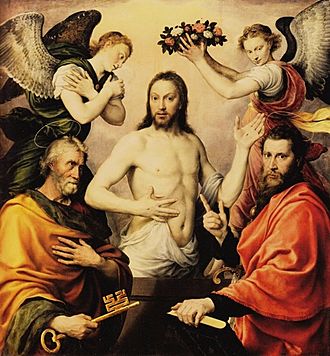Feast of Saints Peter and Paul facts for kids
Quick facts for kids Solemnity of Saints Peter and Paul |
|
|---|---|
 |
|
| Official name | Feast of Saints Peter and Paul, Solemnity of Saints Peter and Paul |
| Observed by | Eastern Orthodox Church Catholic Church Anglican Church Lutheran Church Oriental Orthodoxy Rome |
| Celebrations | Mass |
| Date | 29 June |
| Next time | 29 June 2026 |
| Frequency | Annual |
The Feast of Saints Peter and Paul is a special day celebrated by Christians. It honors two important apostles, Saint Peter and Saint Paul. This day, June 29, remembers their deaths in Rome long ago.
This celebration is very old, going back to the early days of Christianity. The date was chosen to mark either the day they died or when their holy remains were moved.
Contents
Celebrating in Eastern Christian Churches
For Eastern Orthodox and some Eastern Catholic Christians, this feast day is very important. It marks the end of a special time called the Apostles' Fast. This fast begins after Pentecost, which is a Christian holiday celebrating the Holy Spirit.
Even though it's not one of the twelve biggest feasts, it's still considered a "great feast" in the Eastern Orthodox tradition. Often, people celebrate with an all-night vigil, which is a prayer service that starts the evening before. In the Julian calendar, June 29 falls on July 12 in the Gregorian calendar for many years.
In the Russian Orthodox tradition, there's a story about Macarius of Unzha and his "Miracle of the Moose." This miracle is said to have happened during the Apostles' Fast, just before the Feast of Saints Peter and Paul.
Oriental Orthodox Traditions
In the Coptic Orthodox Church and the Ethiopian Orthodox Tewahedo Church, the feast of Saints Peter and Paul is also celebrated. It falls on the 5th day of a month called Epip. This day also marks the end of the apostles' fast in these traditions.
Doukhobor Peace Day
The Doukhobors are a group of Spiritual Christians from Canada. They don't worship saints, but the Feast of St. Peter and St. Paul has always been a day of celebration for them. Since 1895, it has gained a new meaning.
On this day, the Doukhobors remember the "Burning of the Arms." This was when they destroyed their weapons to show they refused to take part in wars. Today, their descendants call it "Peter's Day" (Petro den in Russian). Sometimes, it's also known as "Doukhobor Peace Day."
Celebrating in Western Christian Churches
In the General Roman Calendar, the celebration of Saints Peter and Paul is a very important day called a solemnity. In earlier times, it was ranked as a "Double of the First Class" feast. Before some changes made by Pope Pius XII, this feast was followed by an octave, which means the celebration lasted for eight days.
On this feast day, new metropolitan archbishops receive a special cloth called a pallium from the pope. This pallium is a symbol of their important role.
Holy Day of Obligation
For Latin Church Catholics, this day is a holy day of obligation. This means they are expected to attend Mass. However, bishops in different countries can decide if this obligation applies in their area. For example, in England, Scotland, and Wales, it is a holy day of obligation. But in the United States and Canada, it is not. The U.S. stopped observing it as a holy day of obligation in 1840.
The Church of England celebrates June 29 as a festival. Lutheran churches also celebrate it as a "lesser festival."
Public Holiday and Local Customs
Because Saints Peter and Paul are so important to the Catholic Church, many countries where most people are Catholic observe their feast day as a public holiday. In Rome, it's a public holiday because St. Peter and St. Paul are the patron saints of the city.
In the Apulia region of Italy, this feast was linked to the Tarantella dance for hundreds of years. People used to believe that a bite from a tarantula wolf spider could cause a wild dancing sickness. They thought dancing could cure it, and that Saint Paul's help was needed. These dancing panics were common near the feast day in the 16th and 17th centuries, especially in Galatina, where a church dedicated to Saint Peter and Paul is located.
In Malta, this solemnity is a public holiday called L-Imnarja in Maltese. It's celebrated with festivals in the Buskett Gardens in Rabat during the weekend before the feast.
It is also a public holiday in the Canton of Ticino, Switzerland, and in parts of the Swiss cantons of Lucerne and Graubünden. The feast is a public holiday in Peru and in several towns in the Philippines. In Ormoc, Philippines, there are annual festivals, markets, parades, and pageants on this day, as Peter and Paul are the city's patron saints.
In 1577, the famous painter Peter Paul Rubens was named Peter Paul because he was born during the evening prayers on this feast day.
See also
 In Spanish: San Pedro y San Pablo para niños
In Spanish: San Pedro y San Pablo para niños

